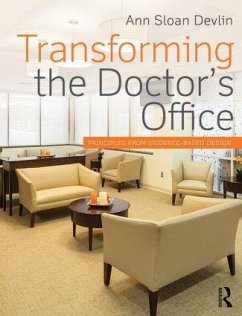Schade – dieser Artikel ist leider ausverkauft. Sobald wir wissen, ob und wann der Artikel wieder verfügbar ist, informieren wir Sie an dieser Stelle.
- Broschiertes Buch
- Merkliste
- Auf die Merkliste
- Bewerten Bewerten
- Teilen
- Produkt teilen
- Produkterinnerung
- Produkterinnerung
An essential reference for physicians, patients, and designers
Andere Kunden interessierten sich auch für
![Motivating Change: Sustainable Design and Behaviour in the Built Environment Motivating Change: Sustainable Design and Behaviour in the Built Environment]() Motivating Change: Sustainable Design and Behaviour in the Built Environment95,99 €
Motivating Change: Sustainable Design and Behaviour in the Built Environment95,99 €![A Catalogue of English Heads: or, An Account of About Two Thousand Prints, Describing What is Peculiar on Each; as the Name, Title, or Office of the A Catalogue of English Heads: or, An Account of About Two Thousand Prints, Describing What is Peculiar on Each; as the Name, Title, or Office of the]() Joseph AmesA Catalogue of English Heads: or, An Account of About Two Thousand Prints, Describing What is Peculiar on Each; as the Name, Title, or Office of the21,99 €
Joseph AmesA Catalogue of English Heads: or, An Account of About Two Thousand Prints, Describing What is Peculiar on Each; as the Name, Title, or Office of the21,99 €![Lettering for Schools and Colleges, for the Office and Workshop ... Lettering for Schools and Colleges, for the Office and Workshop ...]() Frank SteeleyLettering for Schools and Colleges, for the Office and Workshop ...16,99 €
Frank SteeleyLettering for Schools and Colleges, for the Office and Workshop ...16,99 €![The Emerging; A Journey of Healing with Watercolor Flower Mandalas The Emerging; A Journey of Healing with Watercolor Flower Mandalas]() Michele FaiaThe Emerging; A Journey of Healing with Watercolor Flower Mandalas23,99 €
Michele FaiaThe Emerging; A Journey of Healing with Watercolor Flower Mandalas23,99 €![Furniture Including Everything For The Home, Office And Hotel Furniture Including Everything For The Home, Office And Hotel]() Furniture Including Everything For The Home, Office And Hotel23,99 €
Furniture Including Everything For The Home, Office And Hotel23,99 €![Interior Design for Small Dwellings Interior Design for Small Dwellings]() Sherrill Baldwin HalbeInterior Design for Small Dwellings54,99 €
Sherrill Baldwin HalbeInterior Design for Small Dwellings54,99 €![Labyrinths Labyrinths]() Marcia RaffLabyrinths15,99 €
Marcia RaffLabyrinths15,99 €-
Produktdetails
- Produktdetails
- Verlag: Taylor & Francis
- Seitenzahl: 184
- Erscheinungstermin: 26. Juni 2014
- Englisch
- Abmessung: 244mm x 188mm x 13mm
- Gewicht: 522g
- ISBN-13: 9780415840644
- ISBN-10: 0415840643
- Artikelnr.: 40027777
- Herstellerkennzeichnung
- Libri GmbH
- Europaallee 1
- 36244 Bad Hersfeld
- gpsr@libri.de
- Verlag: Taylor & Francis
- Seitenzahl: 184
- Erscheinungstermin: 26. Juni 2014
- Englisch
- Abmessung: 244mm x 188mm x 13mm
- Gewicht: 522g
- ISBN-13: 9780415840644
- ISBN-10: 0415840643
- Artikelnr.: 40027777
- Herstellerkennzeichnung
- Libri GmbH
- Europaallee 1
- 36244 Bad Hersfeld
- gpsr@libri.de
Ann Sloan Devlin is the May Buckley Sadowski '19 Professor of Psychology at Connecticut College, New London, USA. She has published extensively on healthcare environments, investigating how perceptions of the built environment influence judgments of care and comfort. She has written three other books, most recently What Americans Build and Why: Psychological Perspectives (2010).
Preface
Acknowledgments
Introduction
Role of evidence-based design
The patient-centered care movement, Planetree, and the Center for Health Design
Green design, sustainability, and technology
ADA and HIPAA
The role of evidence
Unifying themes in this book
A call to action
Chapter 1. Office Location, Signage, and Identity: Where and Who You Are
Overview: Schemas and patients' expectations
Location
Signage
Parking
Exterior landscaping and image: An overview
Chapter 2. Arriving, Waiting, and Taking Vitals: Setting the Stage
Overview
The spatial continuum: From entrance and reception to interior spaces
Reception space: Expectations and functions
The waiting room: Territoriality, personal space, and privacy
Lighting
Furnishings
Staff areas
The toilet room (restroom)
Chapter 3. Consultation and Examination Spaces: "You Feel Healthier When You're Dressed"
Overview
Anxiety and the medical consultation
Models of consultation
Privacy concerns: Overview
Illumination: Properties of lighting and dynamic lighting systems
Personalization in the office suite
The psychotherapist's office: Continuous consultation and examination
Consultation and exam spaces: A century ago
Chapter 4. The Ambient Environment: Changing the "Sick People's" Atmosphere
Overview: The waiting room should "lose its 'sick people's' atmosphere"
Ambient characteristics: Control, positive distraction, and personalization
Giving patients control and permission
The senses: Visual stimulation and positive distraction
Nature: The real deal
Music as positive distraction
Complimentary food and beverages
Other senses
Safety in the medical suite: By regulation and by association
Closing thoughts
Further reading
Index.
Acknowledgments
Introduction
Role of evidence-based design
The patient-centered care movement, Planetree, and the Center for Health Design
Green design, sustainability, and technology
ADA and HIPAA
The role of evidence
Unifying themes in this book
A call to action
Chapter 1. Office Location, Signage, and Identity: Where and Who You Are
Overview: Schemas and patients' expectations
Location
Signage
Parking
Exterior landscaping and image: An overview
Chapter 2. Arriving, Waiting, and Taking Vitals: Setting the Stage
Overview
The spatial continuum: From entrance and reception to interior spaces
Reception space: Expectations and functions
The waiting room: Territoriality, personal space, and privacy
Lighting
Furnishings
Staff areas
The toilet room (restroom)
Chapter 3. Consultation and Examination Spaces: "You Feel Healthier When You're Dressed"
Overview
Anxiety and the medical consultation
Models of consultation
Privacy concerns: Overview
Illumination: Properties of lighting and dynamic lighting systems
Personalization in the office suite
The psychotherapist's office: Continuous consultation and examination
Consultation and exam spaces: A century ago
Chapter 4. The Ambient Environment: Changing the "Sick People's" Atmosphere
Overview: The waiting room should "lose its 'sick people's' atmosphere"
Ambient characteristics: Control, positive distraction, and personalization
Giving patients control and permission
The senses: Visual stimulation and positive distraction
Nature: The real deal
Music as positive distraction
Complimentary food and beverages
Other senses
Safety in the medical suite: By regulation and by association
Closing thoughts
Further reading
Index.
Preface
Acknowledgments
Introduction
Role of evidence-based design
The patient-centered care movement, Planetree, and the Center for Health Design
Green design, sustainability, and technology
ADA and HIPAA
The role of evidence
Unifying themes in this book
A call to action
Chapter 1. Office Location, Signage, and Identity: Where and Who You Are
Overview: Schemas and patients' expectations
Location
Signage
Parking
Exterior landscaping and image: An overview
Chapter 2. Arriving, Waiting, and Taking Vitals: Setting the Stage
Overview
The spatial continuum: From entrance and reception to interior spaces
Reception space: Expectations and functions
The waiting room: Territoriality, personal space, and privacy
Lighting
Furnishings
Staff areas
The toilet room (restroom)
Chapter 3. Consultation and Examination Spaces: "You Feel Healthier When You're Dressed"
Overview
Anxiety and the medical consultation
Models of consultation
Privacy concerns: Overview
Illumination: Properties of lighting and dynamic lighting systems
Personalization in the office suite
The psychotherapist's office: Continuous consultation and examination
Consultation and exam spaces: A century ago
Chapter 4. The Ambient Environment: Changing the "Sick People's" Atmosphere
Overview: The waiting room should "lose its 'sick people's' atmosphere"
Ambient characteristics: Control, positive distraction, and personalization
Giving patients control and permission
The senses: Visual stimulation and positive distraction
Nature: The real deal
Music as positive distraction
Complimentary food and beverages
Other senses
Safety in the medical suite: By regulation and by association
Closing thoughts
Further reading
Index.
Acknowledgments
Introduction
Role of evidence-based design
The patient-centered care movement, Planetree, and the Center for Health Design
Green design, sustainability, and technology
ADA and HIPAA
The role of evidence
Unifying themes in this book
A call to action
Chapter 1. Office Location, Signage, and Identity: Where and Who You Are
Overview: Schemas and patients' expectations
Location
Signage
Parking
Exterior landscaping and image: An overview
Chapter 2. Arriving, Waiting, and Taking Vitals: Setting the Stage
Overview
The spatial continuum: From entrance and reception to interior spaces
Reception space: Expectations and functions
The waiting room: Territoriality, personal space, and privacy
Lighting
Furnishings
Staff areas
The toilet room (restroom)
Chapter 3. Consultation and Examination Spaces: "You Feel Healthier When You're Dressed"
Overview
Anxiety and the medical consultation
Models of consultation
Privacy concerns: Overview
Illumination: Properties of lighting and dynamic lighting systems
Personalization in the office suite
The psychotherapist's office: Continuous consultation and examination
Consultation and exam spaces: A century ago
Chapter 4. The Ambient Environment: Changing the "Sick People's" Atmosphere
Overview: The waiting room should "lose its 'sick people's' atmosphere"
Ambient characteristics: Control, positive distraction, and personalization
Giving patients control and permission
The senses: Visual stimulation and positive distraction
Nature: The real deal
Music as positive distraction
Complimentary food and beverages
Other senses
Safety in the medical suite: By regulation and by association
Closing thoughts
Further reading
Index.








